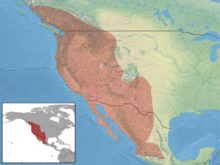Yuma myotis
| Yuma myotis | |
|---|---|
_(11362476624).jpg) | |
| Scientific classification | |
| Kingdom: | Animalia |
| Phylum: | Chordata |
| Class: | Mammalia |
| Order: | Chiroptera |
| Family: | Vespertilionidae |
| Genus: | Myotis |
| Species: | M. yumanensis |
| Binomial name | |
| Myotis yumanensis H. Allen, 1864 | |
 | |
The Yuma myotis (Myotis yumanensis) is a species of vesper bat native to western North America.
Description
The Yuma myotis is a relatively small myotis, measuring 39 to 48 cm (15 to 19 in) in head-body length, with an average wingspan of 24 cm (9.4 in) and a weight of about 6 g (0.21 oz). Individuals vary in color across their range, and can be anything from dark brown to pale tan, or even greyish. The fur is short and dull, and significantly paler, sometimes even whitish, on the underside of the animal. The tail is 27 to 40 cm (11 to 16 in) in length, with only the tip extending beyond the edge of the uropatagium. The calcar is long, extending about 60% of the distance from the ankle to the tail, and, unlike that of many other North American species of Myotis, lacks a keel. The feet are large and broad, and the ears moderately long, with a slim, straight tragus. The head has a short, broad snout, and a rounded cranium.[2]
It is similar to Myotis occultus,[3] but most closely resembles the little brown bat, from which it can only be distinguished through the examination of a number of different features considered together.[4]
Distribution and habitat
First described from specimens captured near Fort Yuma, the Yuma myotis is found throughout much of western North America.[1] It is found in a variety of western lowland habitats, from arid thorn scrub to coniferous forest, but always close to standing water such as lakes and ponds.[5]
Six subspecies are recognized:[2]
- M. y. iambi - limited to central Baja California Sur
- M. y. lutosus - Sinaloa to the State of Mexico
- M. y. oxalis - limited to central California
- M. y. saturatus - British Columbia, western Washington and Oregon, and most of California
- M. y. sociabilis - eastern Washington and Oregon, Idaho, western Montana, and north-eastern California
- M. y. yumanensis - south-eastern California, southern Nevada, Utah and Colorado, and across to western Texas and north-western Mexico
Biology and behavior
Yuma myotis are nocturnal, and forage for insects above the surface of slow moving water or in vegetation close to the water's edge. They are maneuverable fliers, with a wing aspect ratio of about 6.45, and can fly at up to 9 mph (14 km/h).[6] They feed on beetles and soft-bodied insects, but are opportunistic hunters with no preference for particular prey. Instead, they feed on whatever is most common in their areas; for example, they feed primarily on moths in Texas,[7] but on flies in Oregon.[2]
Although their natural roosts include caves, rock crevices, and hollow trees, they are more commonly found today in artificial structures close to water. In suitable locations, they have been reported to establish colonies with as many as 10,000 members.[2] They are relatively inactive during the winter,[8] spending some of the time in torpor, but probably do not migrate any significant distance.[9] The echolocation calls of Yuma myotis are frequency modulated and sweep abruptly from 59 to 72 kHz down to 45 to 50 kHz.[2]
Mating occurs in the fall, but the females retain the sperm for several months before conception occurs. The single young are born between late May and late June, and weigh around 1.4 g (0.05 oz) at birth. Initially blind and hairless, their eyes open around the fifth day, and they are completely furred by day nine.[2]
See also
References
- 1 2 Arroyo-Cabrales, J. & Ticul Alvarez Castaneda, S. (2008). "Myotis yumanensis". IUCN Red List of Threatened Species. Version 2010.4. International Union for Conservation of Nature. Retrieved 7 May 2016.
- 1 2 3 4 5 6 Braun, J.K.; et al. (June 2015). "Myotis yumanensis (Chiroptera: Vespertilioindae)". Mammalian Species. 47 (918): 1–14. doi:10.1093/mspecies/sev001.
- ↑ The Mammals of Texas (2004) by David J. Schmidly and William B. Davis, page 90.
- ↑ Rodhouse, T.J.; et al. (December 2008). "Field identification of Myotis yumanensis and Myotis lucifugus: a morphological evaluation". Western North American Naturalist. 68 (4): 437–443. doi:10.3398/1527-0904-68.4.437.
- ↑ Duff, A.A. & Morrell, T.E. (May 2007). "Predictive occurrence models for bat species in California". Journal of Wildlife Management. 71 (3): 693–700. doi:10.2193/2005-692.
- ↑ Hayward, B. & Davis, R. (May 1964). "Flight speeds in western bats". Journal of Mammalogy. 45 (2): 236–242. doi:10.2307/1376986.
- ↑ Easteria, D.A. & Whitaker, J.O. (November 1972). "Food habits of some bats from Big Bend National Park, Texas". Journal of Mammalogy. 53 (4): 887–890. doi:10.2307/1379227.
- ↑ Boyles, J.G.; Dunbar, M.B. & Whitaker, J.O. (October 2006). "Activity following arousal in winter in North American vespertilionid bats". Mammal Review. 36 (4): 267–280. doi:10.1111/j.1365-2907.2006.00095.x.
- ↑ Dalquest, W.W. (July 1947). "Notes on the natural history of the bat Myotis yumanensis in California, with a description of a new race". The American Midland Naturalist. 38 (1): 224–247. doi:10.2307/2421638. JSTOR 2421638.
